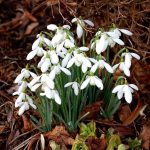Who will be the first to spot a snowdrop?
Posted:2 January 2011
Galanthus is a small genus of about 19 species of bulb commonly found throughout Europe and western Asia in upland woodland and rocky sites. Galanthus bloom mainly from late winter to mid-spring, though in their natural habitat they often flower just as the snow is starting to melt.
 The name Galanthus is derived from the Greek words gala, meaning milk, and anthos, meaning flower, in allusion to the colour of the flowers. The plants are more commonly known as ‘snowdrops, from the German Schneetropfen – this common name refers to a style of earring popular in the 16th and 17th centuries in Germany.
The name Galanthus is derived from the Greek words gala, meaning milk, and anthos, meaning flower, in allusion to the colour of the flowers. The plants are more commonly known as ‘snowdrops, from the German Schneetropfen – this common name refers to a style of earring popular in the 16th and 17th centuries in Germany.
One of the best and boldest of the snowdrops, with rounded bell-shaped scented flowers, is variety ‘S.Arnott’ – a favourite of ours!
- Family: Amaryllidaceae
- Height & spread: 15cm (6in) x 8cm (3in)
- Form: Bulbous perennial
- Soil: Moist but well-drained, moderately fertile
- Aspect: Cool shade
- Hardiness: Fully hardy
This snowdrop is vigorous, with narrow, grey-green leaves 7-16cm (3-6in) long. It has large white flowers, which have an inverted V-shaped green mark at the tip of each inner tepal. They are 2.5-3.5cm (1-1.5in) long, strongly honey-scented and are produced in winter and early spring. They look wonderful planted with dark-leaved plants, like Ophiopogon planiscapus Nigrescens or with bright yellow winter aconites, or carpeting the woodland floor under a flowering witch hazel. 
Cultivation: Snowdrops grow well in cool shade in any humus-rich, moist but well-drained soil that does not dry out in summer.
They are prone to narcissus bulb fly, which will tunnel into the bulbs and destroy them, and also grey mould (botrytis), which will appear on the leaves but then rot the bulbs.
Propagation: Sow seed as soon as ripe in containers in an open frame, though as Galanthus species readily hybridise the seed may not come true.
Propagate by twin scaling in summer. With this technique a bulb is cut into pairs of scales, each of which produces bulblets.
Lift and divide clumps of Galanthus “in the green”, as soon as the leaves begin to die back after flowering. Replant each bulb individually, at the same level as before, in holes sufficiently wide to spread out the roots.
When all else is bare, it lifts the spirits when you spot patches of snowdrops appearing under shrubs and trees
If you want to see many, many varieties of Galanthus growing wild (including many rare varieties) – join us on 12 February for an early spring visit to the stunning gardens of Anglesey Abbey. Truly a garden for all seasons – but particularly beautiful in February when it is at it’s most spectacular, and drifts of white snowdrops and yellow aconites add colour to the frosty landscape (details in the DIARY on this website)…

